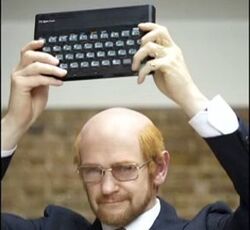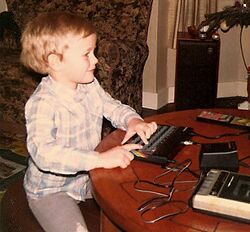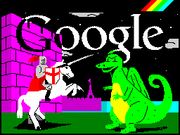ZX Spectrum
The ZX Spectrum, released to the public in 1982, was the UK's first home-grown supercomputer built to compete in the "Computer Race" against the US who were working on their own secret project, the Commodore 64. Capable of a mind-blowing 3.5 Megahertz (that's 3.5 MILLION hertz) and boasting 48 kilobytes of RAM (that's 48 THOUSAND bytes), the 8-bit wonder went on to ultimately lose the race against the similarly specced Commodore 64, despite being the easiest to copy and share pirated games. The ZX Spectrum was the first casualty in what would become known as the Console Wars, when boys from all across the world's school playgrounds engage in fair, reasoned and unbiased debate over why their gaming machine is better than their opponents'.
Origins[edit]
The ZX Spectrum was first announced in 1980 by the then-Prime Minister of the UK, Maggie Thatcher in an attempt to lift the nation's spirits and strive towards a unified goal, making the promise that the UK would be the first nation on Earth to release a sub-£200 supercomputer before the end of the decade in a nod to her hero JFK's mission to put a man on the moon twenty years earlier. The work was outsourced to the lowest bidder, which happened to be Sinclair Research, a company renowned for producing cheap and nasty digital watches and calculators. The CEO, Clive Sinclair decided to stick with what they knew and design a slightly bigger calculator, one which could plug into a TV set, a new technology which was also becoming popular at the time.
Development[edit]

In the summer of 1980 Sinclair Research ramped up its calculator production lines and employed every child under the age of ten in a five mile radius. Clive Sinclair then decided that he had better start designing Thatcher's shiny new computer. As he had no design skills himself (which was obvious to anyone who had bought one of his transistor radios he had built in his garage) he ran a competition for the best design from the local Cambridge art school students. The entry which won was actually submitted by a patient who escaped from the nearby mental institution and was pretending to be an art student for the day.
Sinclair then went scavenging in the dumpster of his neighbour and nemesis Acorn Computer[1] for some spare electronic parts to put inside his own machine. Once he had collected enough chips, resistors and diodes and taught his young workforce how to solder, the computer went into full production over the next two years. When the first ZX Spectrum came off the production line a triumphant Clive Sinclair emerged from the building holding it above his head proclaiming victory.
Reception[edit]
The ZX Spectrum was released to great fanfare and disappeared quickly off store shelves. Luckily lots of people bought some before that happened. Following its success, the computer was exported to every British outpost around the world to allow the colonists to partake in the technological revolution too. A group of dissenters in the US who were unhappy with the Commodore 64 project made a secret deal with the UK government to copy the ZX Spectrum and sell it in the US under a false name. Thus the Timex/Sinclair 2068 was born. However it suffered a design flaw in that no games from the UK (which is where all the best games came from) would work on it and so no one bought it. Timex buried the unsold stock in a landfill and went back to making watches instead.
The ZX Spectrum brought so much money and respect to the Queen of England that Clive Sinclair was knighted in recognition and given the title of First Knight of the Order of the Spectrum. Another peddler of cheap electronic wares named Alan Sugar became so jealous of Sinclair's knighthood that he bought the company and produced his own computers with Sinclair's name on them. This delighted the Queen as she was an avid Sinclair user so she awarded Sugar the position of Lord of the Order of the Spectrum.
Death[edit]
The ZX Spectrum sadly passed away on September 12, 1993 when Lord Sugar finally removed its life support, following the steep decline in interest in electronic devices that were unable to connect to the Internet. A bed-side vigil was held by the five remaining Spectrum users who had not yet accepted their fate and upgraded to a 16-bit rival machine. A State memorial service was planned but was abandoned as the Queen was too busy entering some 68000 assembly code on her Amiga. Instead the Spectrum was taken to the local rubbish tip where for the cost of a fiver it was dumped along with the uneaten sandwiches from the unheld memorial service.
Legacy[edit]
Matthew Smith is still working on the development of Jet Set Willy 3, which has an expected release date of some time this century. Originally intended for the iPhone platform, Smith began re-writing it for the Spectrum when Apple rejected the game on grounds of glorification of debauchery, and also for the inclusion of "Willy" in the app title.
Elite Systems, a name familiar to all former Spectrum gamers for its range of elitist and high-brow games, has released its back catalogue on iDevices for the benefit of today's generation of mobile gamers who demand the types of games their mothers and sisters wouldn't play. In conjunction, the company is selling the 'Spectrum lite', a keyboard that looks like a Spectrum and smells like a Spectrum but doesn't crash like a Spectrum. This keyboard allows elitist gamers to play their favourite Elite games on their elitist mobile devices while passers-by look at them oddly.
Technology[edit]
Keyboard[edit]
The defining feature of the ZX Spectrum was its ergonomically designed rubber keyboard which prevented people typing too fast and hurting their fingers. The soft and squishy keys also minimised callouses on typists' fingertips. The ingenious "one-touch typing" design further slowed keyboard input by forcing the user to hunt around on the keyboard for the word they needed.
Display[edit]
The ZX Spectrum was capable of displaying HD images in its native 256x192 pixel resolution in full colour (of which only the eight most important were used, including black. It was generally accepted (by the Sinclair marketing department) that the human eye is incapable of seeing more than those eight colours anyway).
Sound[edit]
The ZX Spectrum's audio capabilities consisted of various beeps, chirps and screeching noises. Later in its life programmers were also able to wrestle a few different buzzing sounds out of its speaker. None of this mattered though as computer gamers at the time were more adept at using their imaginations and making their own explosion noises with their mouths.
Storage[edit]
The storage medium chosen by Sinclair was the audio cassette as he wanted users of his computer to sit and wait for half an hour listening to every bit and byte as a program made its way into the RAM banks, thereby forming a closer relationship to the hardware and developing a Zen-like patience, the likes of which is unheard of in this age of instant gratification.
Due to the abundance of trashy throwaway music in the 80s, all software was pirated using recycled Human League and Bananarama cassettes. No software was actually legitimately sold in the history of the ZX Spectrum and all games companies only survived by manufacturing illegal drugs on the side.
See also[edit]
References[edit]
- ↑ Following their battle over the BBC Micro which Sinclair lost.
| ||||||||||||||||||||||||||



